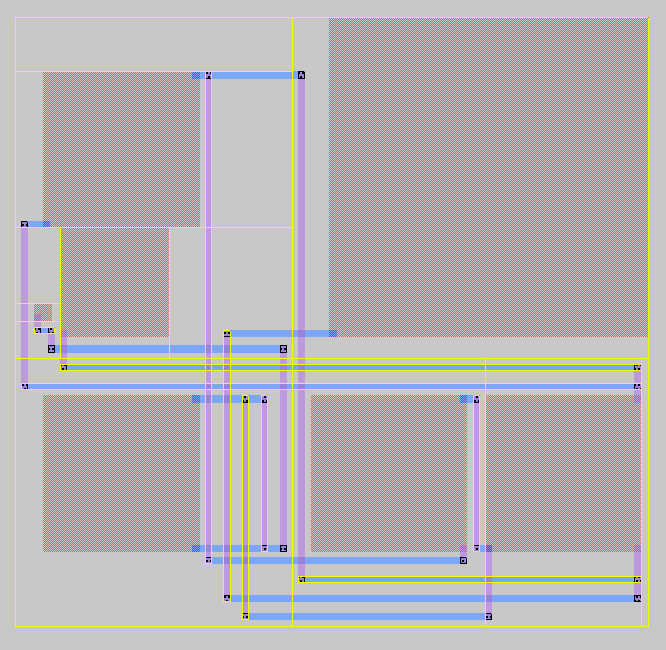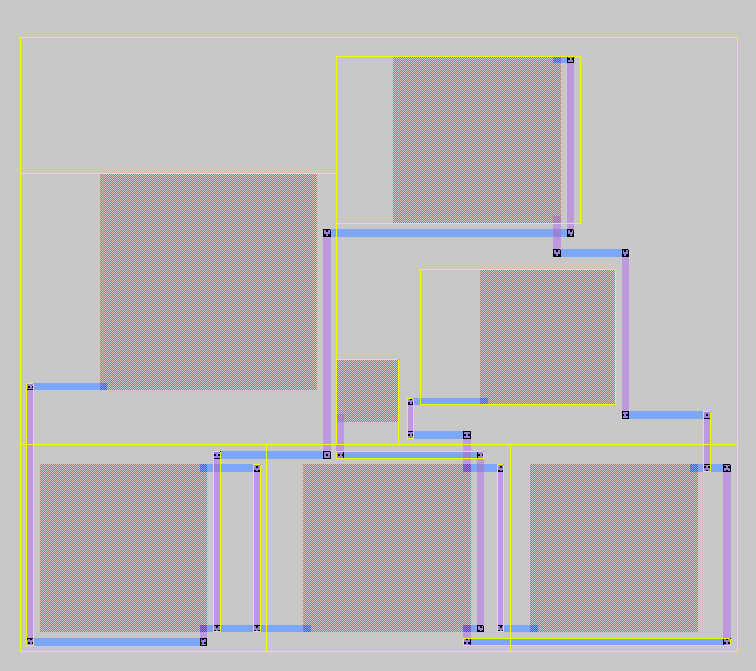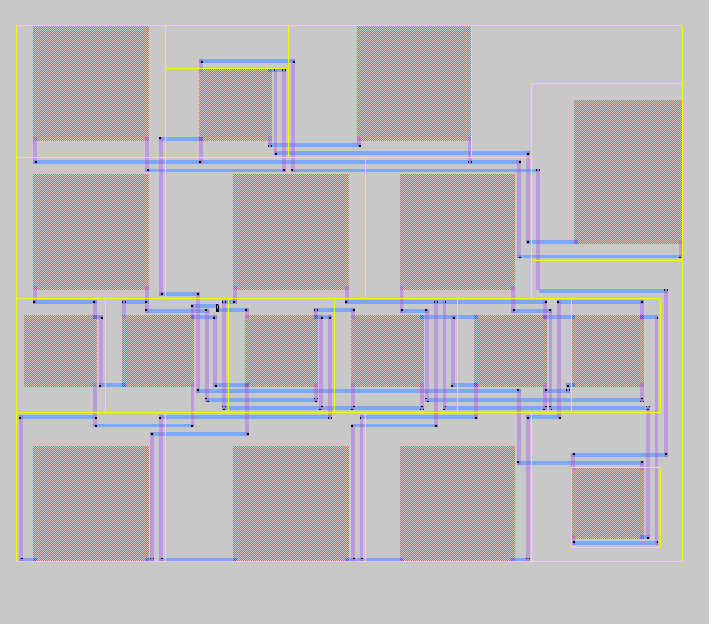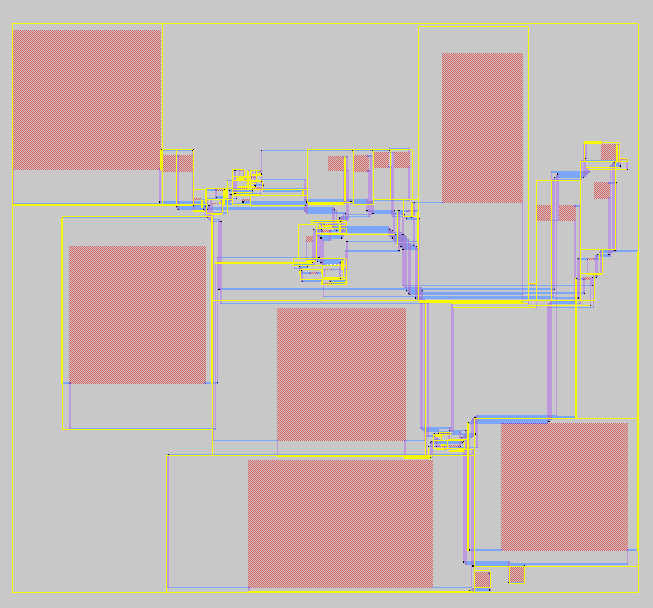Rhapsody: Methodology and Algorithms for
Automated Architecture Generation for Analog and
Mixed-Signal Systems
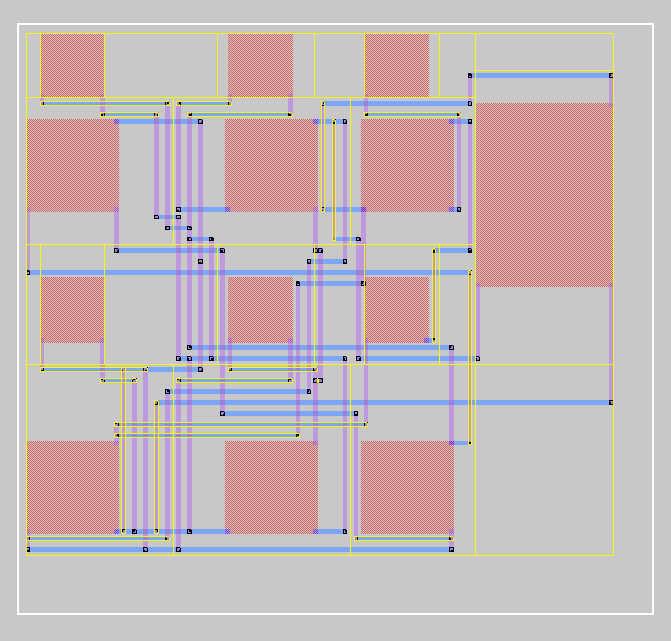
Research Team
Alex
Doboli, Hua Tang and
Hui
Zhang
Research Goal and Objectives
Our goal was to develop methodologies and techniques for automated
generation of high-level analog system architectures. This task is know
as high-level architecture generation(HAG).
HAG bridges the gap between an abstract description of a system, e.g.
in MATLAB or VHDL-AMS, and the circuit level implementation of the system.
Inputs to HAG are abstract, unsized netlist of blocks, as well as performance/design
constraints for the final implementation. Typical performance constraints
refer to silicon area, offset voltages, bandwidth, poles and zeros, settling
time, signal-to-noise ratio (SNR), dynamic range (DR), and so on. The output
of HAG is the sized architectural netlist, in which each block has its
performance/design requirements identified. After HAG, circuit synthesis
is performed in a subsequent step to create the transistor level design
for each block in the system architecture.
The proposed HAG methodology includes three main activities:
Block parameter exploration/optimization:
This step finds the block parameter values that optimize the imposed system
performance. This module also evaluates the quality of each architectural
solution. Block parameter exploration relies on exploration algorithms
driven by performance model estimation.
Floorplanning and global routing: This
activity designs the silicon floorplan of a system and routes the inputs,
outputs and power lines of the analog blocks in an architecture. Floorplanning
and global routing are very important for extracting and estimating layout
parasitic, i.e. crosstalk and RLC interconnect parasitic.
System performance evaluation: This
task involves fast yet accurate performance estimation. Evaluation addresses
linear and non-linear parameters in time and frequency domains.
Importance
Without proper HAG tools, it will be impossible to address the increasing
productivity gap and benefit from upcoming technological advancements.
Every year, the number of transistors per chip rises by 58%, whereas the
design productivity increases by only 21%. In addition, modern SoC are
characterized by complex functionalities, diverse performance requirements,
and heterogeneous components (e.g., digital, analog and RF). For example,
MPEG-4 and H.263 encoders, network processors, and software radio are typical
mixed-signal SoC. Digital hardware and software are optimized for cost,
speed, and power consumption. In contrast, analog and RF circuits must
meet specific constraints, e.g. linearity, bandwidth, dynamic range, and
image rejection. Hence, HAG approaches are needed for mixed-domain specification,
trade-off exploration, and integration.
Related Publications
Hua Tang, Hui Zhang, A. Doboli, "Refinement based
Synthesis of Continuous-Time Analog Filters Through Successive Domain Pruning,
Plateau Search and Adaptive Sampling", under review, IEEE Transactions
on CAD, May 2004.
Doboli, R. Vemuri, "Behavioral Modeling for High-Level
Synthesis of Analog and Mixed-Signal Systems from VHDL-AMS", IEEE Transactions
on CAD of Integrated Circuits and Systems, Vol. 22, No. 11, 2003.
A. Doboli, R. Vemuri, "Exploration-Based High-Level
Synthesis of Linear Analog Systems Operating at Low/Medium Frequencies",
IEEE Transactions on CAD of Integrated Circuits and Systems, Vol. 22, No.
11 2003.
H. Tang, H. Zhang, A. Doboli, "Towards High-Level
Synthesis of Analog and Mixed-Signal Systems from VHDL-AMS Specifications
- A Case Study for a Sigma-Delta Analog-Digital Converter", in C. Grimm,
editor, "Languages for System Specification and Verification", Kluwer,
2004.
H. Zhang, A. Doboli, S. Doboli, "Fast Time-Domain
Simulation Through Combined Symbolic Analysis and Piecewise Linear Modeling",
Proc. of the IEEE Behavioral Modeling and Simulation Workshop (BMAS'04),
San Jose, 2004.
H. Zhang, A. Doboli, "Fast Time Domain Symbolic Simulation
for Synthesis of S-D Analog-Digital Converters", Proc. of the International
Symposium on Circuits and Systems, Vancouver, 2004.
H. Tang, H. Zhang, A. Doboli, "Towards High-Level
Synthesis of Analog and Mixed-Signal Systems from VHDL-AMS Specifications
- A Case Study for a Sigma-Delta Analog-Digital Converter", Forum on Specification
and Design Languages (FDL'03), Frankfurt, 2003.
S. Doboli, A. Doboli, "Piecewise-Linear Modeling
of Analog Circuits using Trained Feed-Forward Neural Networks and Adaptive
Clustering of Hidden Neurons", Proc. of the 2003 International Joint Conference
on Neural Networks (IJCNN), Portland, 2003.
H. Tang, H. Zhang, A. Doboli, "Synthesis of Continuous-Time
Filters and Analog to Digital Converters by Integrated Constraint Transformation,
Floorplanning and Routing", Proc. of the Great Lakes Symposium on VLSI
(GLSVLSI), Washington DC, 2003.
H. Tang, H. Zhang, A. Doboli, "Layout-Aware Analog
System Synthesis Based on Symbolic Layout Description and Combined Block
Parameter Exploration, Placement and Routing", Proc. of the Annual Symposium
on VLSI (ISVLSI), Tampa, 2003.
S. Doboli, G. Gothoskar, A. Doboli, "Extraction of
Piecewise-Linear Analog Circuit Models from Trained Neural Networks using
Hidden Neuron Clustering", Proc. of the Design, Automation and Test in
Europe Conference (DATE), Munich, 2003.
S. Doboli, G. Gothoskar, A. Doboli, "Piecewise-Linear
Modeling of Analog Circuits Based on Model Extraction from Trained Neural
Networks", Proc. of the Behavioral Modeling and Simulation Workshop (BMAS),
Santa Rosa, 2002.
H. Tang, A. Doboli, "Layout-Aware Synthesis for Analog
Systems Based on Combined Block Sizing, Floorplanning and Global Routing",
poster, 2002 ASIC/SOC Conference, September 25-27 2002, Rochester, NY.
H. Tang, A. Doboli, "Employing Layout Templates for
Synthesis of Analog Systems", Proc. of the 45th Midwest Symposium on Circuits
and Systems, Tulsa, OK, August 6-8 2002.
Overview of the high-level architecture generation
methodology
The developed HAG methodology and algorithms include two synthesis components
and one simulation module. The two synthesis components implement a two
phase HAG process. Phase 1 corresponds to layout independent synthesis,
and is continued by Phase 2, layout aware HAG. Phase 1 tackles a
simplified synthesis problem (without layout parasitic), but uses minimal
designer knowledge as input. The outputs of Phase 1 are inputs for Phase
2. Phase 2 considers layout parasitic but starts from the feasible design
points found in Phase 1. The third module is fast yet accurate simulation
methodology. We mainly focused on fast simulation of Sigma-Delta analog
to digital converters (ADC).
Figure 1 presents the layout independent high-level
architecture generation and system synthesis phase. Inputs to
the flow are system architectures and performance requirements in AC and
transient domains. Architectures are netlists of active circuits, such
as op amps and GmC, and passive elements, like resistors and capacitors.
Synthesis output is a set of performance satisfying system architectures
having all their resistors and capacitors sized, and with circuit performance
constraints identified, like op amp/GmC gains, poles, I/O impedances, and
so on. For the identified circuit constraints, op amp/GmC transistors can
be sized using state-of-the-art circuit synthesis tools.
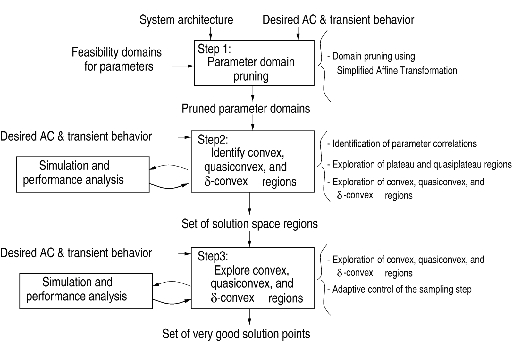
Figure 1: Phase 1 - Layout independent high-level architecture
generation}
The flow consists of three successive steps:
Parameter domain pruning. The first
step eliminates plateau regions, which largely violate performance constraints,
thus determine large cost function values.
Finding convex, quasiconvex and d-convex
regions. After parameter domain pruning, the remaining regions
are subject to a filtering process that identifies convex, quasiconvex,
and d-convex regions by eliminating remaining
plateau or quasiplateau areas. The algorithm for this step is called plateau
search, and it includes distinct exploration strategies for different space
region types. Simulated annealing was used for convex, quasiconvex and
d-convex
regions. For plateau and quasiplateau, the developed strategy conducts
a uniform sampling of the space, as the goal was to isolate other promising
regions, and not improve upon current points (like for convex regions).
Exploring convex, quasiconvex and d-convex
regions. This step isolates good quality local optima situated
in the regions found at the end of the second step. This step uses an adaptive
sampling step, so that rift regions are also properly analyzed.
The second phase is layout-aware HAG.
It combines block parameter exploration, block placement and global signal
routing. The method combines (1) block placement and (2) global routing
with (3) block parameter exploration. Inputs to the methodology are system
architectures with parameters sized at Phase 1 (layout independent HAG).
AC and transient performances are evaluated for each circuit using SPICE
simulations. There are two key elements for this technique: (1) an original
layout representation to uniformly express block parameter exploration,
placement, signal routing under precise modeling of layout parasitic, and
(2) specific algorithms that use the layout representation for synthesis.
Layout is described symbolically using Layout Constraint Graphs (LCG).
LCGs present mathematical constraints for block dimensions, block positions,
wire routings and symmetries. The proposed synthesis algorithms use LCGs
for block parameter search, block moving and swapping, block overlapping
resolution and wire routing.
The third component represents a new approach to fast
time-domain simulation of analog systems that contain nonlinear
parameters. Without trading accuracy, the proposed technique achieves speed-ups
of more than 10nx as compared to numerical (Spectre) simulation by generating
compiled-code for simulation. Code generation relies on calculating symbolic
expressions for the output voltages and currents, and the state variables
of a system. Code optimization identifies and eliminates all loop invariants,
and propagates constant sub-expressions present in the simulation loop.
Code generation uses detailed structural macromodels for the building blocks
(OTA, opamp, and comparator), including non-idealities, like finite gain,
poles and zeros, CMRR, phase margin, fall and rise time, and so on. Nonlinear
parameters are described using piecewise linear (PWL) models. Our research
focused primarily on fast simulation of Sigma-Delta ADC.
Additional Information
Following are additional insight into Rhapsody synthesis environment:
Rhapsody synthesis tool - a
layout-aware, user-friendly analog system synthesis environment. Inputs
are structural descriptions of an architecture, and outputs are architectural
blocks with their parameters identified and MAGIC files for the system
floorplan and global routing. The tool was realized in C/C++, and runs
under UNIX OS. A Graphical User Interface (GUI) was also included. Snapshots
from the tool: overview, new project
definition, running, ... running,
result 1 and result 2.
Synthesis results for several high frequency
filters (1MHz-100MHz range) and Sigma-Delta ADC (2nd, 3rd, and 4th order).
Other synthesis results:
3rd order elliptic filter (100MHz): 3rd order Sigma-Delta
ADC:
3rd order elliptic filter (12MHz):
4th order Sigma-Delta ADC:
6th order filter:
